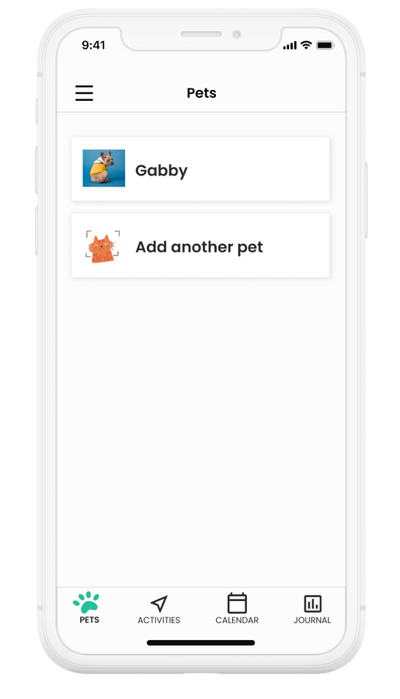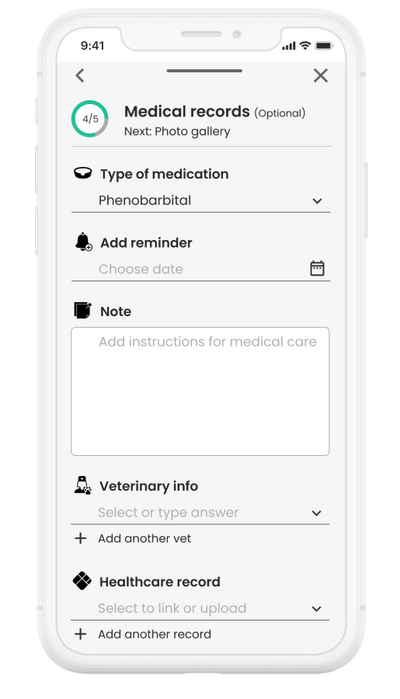Petsweet iOS Mobile App
Easy peasy all-in-one pet management app design

The Solution
Enables users to create accounts, onboard multiple pets, add essential information, and set reminders for activities like vet visits or vaccinations. This centralized experience simplifies pet management, reduces the stress of scattered information
Overview
With countless apps that each only solves one problem, it only creates more frustration. If there was a tool that can help pet owners manage all pets' files in one place, how much easier life would be! I designed an all-in-one tool that manages everything related to pets’ health and organizes records or reminders to make users enjoy more happy moments of having pets and reduce frustrations of pet care.
Business opportunities
There is no all-in-one super app for pet management on the market. Not only could it help pet owners better manage their pet's files and activities, but this app would also be the perfect tool to recommend local pet services or vets to pet owners. In the current circumstances, many pet owners would call or Google those services every time when needed. However, my vision for this app is to provide both pet owners and pet services ultimately.
- 3 rounds of iterations
- 100% of users completed tasks error-free
Outcomes
Solo designer
Role
2021 (1 month)
Duration
💡Conceptual
Status
UX/UI, wireframe, prototype, strategy, research, testing
Contribution
iOS mobile app
Platform
Pet services
Industry
The Challenges
The biggest challenge was to figure out what should be included in the MVP and how to structure the information architecture.

The Approaches
I focused on enhancing trust and allowing people to choose what information to add and designed an MVP iOS app for people to create an account and set reminders.

of pet industry customers are GenX and Millennials.

of Millennials are willing to spend more on sustainable pet products.

of female spend $21 - $100 per month on pets
Discover & Define The Problems
I researched the pet services market before and after the pandemic and found that:
1) GenX and Millennials make up 57% of the pet services market.
2) Millennials are more eco-friendly on pert-parenting and willing to spend more on sustainable pet products.
3) Females are more willing to spend on pet goods and services.
Take A Look At The Market And Data...
What Did The Competitors Do Right And Wrong?
Missing super app
Although popular competitors offer various activity tracking, training, and vet appointment booking and have a large user base, they usually only focus on one area.
No way to store pets medical records
Storing medical records isn't feasible for many apps, yet every veterinarian requires pet owners to fill out pet information every time.

2. The primary pain points are to store pets' information in one place and remind themselves to take care of pets.

1. Everyone cares about the health of their pets and has struggled during their pet care process.

User Interview Findings
I found that women spent more time and money on their pets from market research and competitor analysis and decided to conduct interviews with women. The participants are six women in total; 4 Females, age 22 - 31 years old, full-time employees or students; 2 Females, age 55-60 years old, retired — questions around the following areas to find out their habits and pain points.
Who Are We Designing For?
I created two personas to be more emphatical and specific with the users I'm designing for.
These two groups of audiences are both pet owners, but each has different pains and needs when comes to caring for pets. I used Fiona and Jenn as reference points while designing the solutions, which provided support for my decisions.


What Can We Build To Fulfill User Needs?
After identifying the problems, I realized that the scope was too big. Due to the time given, I decided to approach the problems by first prioritizing the user needs. After I discussed my feature list with peers in my group crits and mentor sessions, I then focused on the following two features: Add pet information and Set reminder.
What Is The Context?
Once I learned more about my users' needs and understood their excitement and real thoughts. I created a user flow around scenarios to visualize how they would react to situations and make decisions.


"How might we help users give pets medicine on-time?"
Because the way we structure the information has a direct impact on how people interact with the app, I took a decent amount of time in creating information architecture. I analyzed apps pet management apps and human health management apps to understand the architecture and iterated on it after getting feedback from other designers and my mentor.
My goal was to make the pets' health management experience delightful and ease confusion. Keeping this goal and people's needs in mind, I worked out an information architecture that presents the essential features in the first layer so people can access them more intuitively.
I presented my research to my mentor and in my group crits, people suggested I add a customize category to activities along with adding activities from the Activities category so people would have multiple ways to accomplish the task of training/walking pets.
However, due to time constraints, I couldn't add them to my MVP list.

Wireframes
I used wireframes to create a more easy-to-follow user flow and explored potential pathways for adding pet information and reminders.

A Brand New Look
After analyzing other brand styles, I decided to choose green as the brand color because of its calmness and the sense of welcoming. Then I sketched out some logos and digitized them. After speaking with my mentor and some target users, I decided to choose #3 because of its unique look, a combination of pet paw and heart.
Design - Test - Iterate - Repeat
Mindful design validates users’ needs and cares for their motivations. Designing in solving individual problems rather than entire flows ensures the interface is flexible and open, and users empower the relationship with target users.
The following are some moments I think would be important based on my research. Further moments and features would likely be uncovered in the next steps.
Sign up as a new user
Transparency is key. Informing users know what this app does and giving them the right to decide whether continue or not.
"What if I don't want to add all details at once?"
Someone who just signed up might not be comfortable to fill all information at once. Giving them choices to do it now or later to reinforce the relationship.
"Can I set up a reminder?"
Someone wanting to add a reminder might ask questions like, “How can I remind myself to do medicine fill today? Can I link it to other platforms?” In this case, they would click the “+” to add a reminder to the existing schedule.
"I'd like to track my pets' activities to keep them healthy and happy."
Someone using the app to track pet’s activities can also find tutorial videos in the section (upcoming features). They can choose to start tracking or watching tutorials first.

Adding Pet Information
Future Roadmap
Through the synthesis of research results, I discovered major discrepancies between pet owners' behaviors and needs and what the market offers. As I had a limited timeline to deliver a product, I decided to develop an MVP that matches people's most basic needs to retain them and implement it over time.
Final Thoughts
Significantly, 100% of users completed the tasks with a 100% error-free rate. Overall, users found the app easy to use, and it matched their expectation for a pet management app.

Recommendation
How might vets and other pet services utilize this app to provide pets owners better services based on their daily routines?

Insurance Plan
How might insurance plans be added to offer users more accurate in or out-of-network services?

Health Insights
How might this app integrate data to generate insightful feedback to pets owners for better pet caring?
Things I would do differently...
-
Focusing more on the essential features and being more specific on solving one problem at a time;
-
Working with developers sooner, I did ask an engineer friend how to use API during my design, however, not being able to work with developers directly limited my ability to understand constraints and measure my scope.
To control the design in scope and deliver it on time is not easy, especially when designing a hypothetical project and trying to meet so many people's needs. If I had to do this again, I would try to focus more on the essential flows before getting into details and micro-interactions.










































